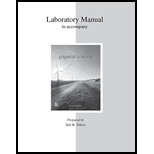
Concept explainers
How much time is required for a sound to travel 1 mile (5,280.0 ft) if the air temperature is:
a. 0.0°C?
b. 20.0°C?
c. 40.0°C?
d. 80.0°C?
(a)
The time required for the sound wave to travel
Answer to Problem 16PEB
Solution:
Explanation of Solution
Given data:
The distance travelled by the sound is
Formula used:
Write the expression for the time.
Here,
Explanation:
Refer to the table 5.1 given inchapter 5. The velocity of sound at
Substitute
Conclusion:
The time required by the sound to travel
(b)
The time required for the sound wave to travel
Answer to Problem 16PEB
Solution:
Explanation of Solution
Given data:
The distance travelled by the sound is
Formula used:
Write the expression for the velocity of sound at the given temperature.
Here,
Write the expression for the time.
Here,
Explanation:
The velocity of sound at
Here,
Substitute
Calculate the time required by the sound to travel
Substitute
Conclusion:
The time required by the sound to travel
(c)
The time required for the sound wave to travel
Answer to Problem 16PEB
Solution:
Explanation of Solution
Given data:
The distance travelled by the sound is
Formula used:
Write the expression for the velocity of sound at the given temperature.
Here,
Write the expression for the time.
Here,
Explanation:
The velocity of sound at
Here,
Substitute
Calculate the time required by the sound to travel
Substitute
Conclusion:
The time required by the sound to travel
(d)
The time required for the sound wave to travel
Answer to Problem 16PEB
Solution:
Explanation of Solution
Given data:
The distance travelled by the sound is
Formula used:
Write the expression for the velocity of sound at the given temperature.
Here,
Write the expression for the time.
Here,
Explanation:
The velocity of sound at
Here,
Substitute
Calculate the time required by the sound to travel
Substitute
Conclusion:
The time required by the sound to travel
Want to see more full solutions like this?
Chapter 5 Solutions
Lab Manual for Physical Science
- Calculate the speed of sound on a day when a 1500 Hz frequency has a wavelength of 0.221 m.arrow_forwardAir temperature in the Sahara Desert can reach 56.0°C (about 134°F). What is line speed of sound in air at that temperature?arrow_forwardWind gusts create ripples on the ocean that have a wavelength at 5.00 cm and propagate at 2.00m/s. What is their frequency?arrow_forward
- What is the minimum speed at which a source must travel toward you for you to be able to hear that its frequency is Doppler shifted? Thai is, what speed produces a shift of 0.300% on a day when the speed of sound is 331 m/s?arrow_forwardAn interstate highway has been built through a neighborhood in a city. In the afternoon, the sound level in an apartment in the neighborhood is 80.0 dB as 100 cars pass outside the window every minute. Late at night, the traffic flow is only five cars per minute. What is the average late-night sound level?arrow_forwardDolphins make sounds in air and water. What is the ratio of the wavelength of a sound in air to its wavelength in seawater? Assume air temperature is 20.0°C.arrow_forward
- Dolphins make sounds in air and water. What is the ratio of the wavelength at a sound in air to its wavelength in seawater? Assume air temperature is 20.0°C.arrow_forwardWhat frequency sound has a 0.10m wavelength when the speed of sound is 340 m/s?arrow_forwardShow mat the speed of sound in 20.0°C air is 343 m/s, as claimed in the text.arrow_forward
- Transverse waves are sent along a 5.00-m-long string with a speed of 30.00 m/s. The string is under a tension of 10.00 N. What is the mass of the string?arrow_forwardWave speed is equal to frequency times ___. (6.2)arrow_forwardA sound wave propagates in air at 27C with frequency 4.00 kHz. It passes through a region where the temperature gradually changes and then moves through air at 0C. Give numerical answers to the following questions to the extent possible and state your reasoning about what happens to the wave physically. (a) What happens to the speed of the wave? (b) What happens to its frequency? (c) What happens to its wavelength?arrow_forward
 College PhysicsPhysicsISBN:9781938168000Author:Paul Peter Urone, Roger HinrichsPublisher:OpenStax College
College PhysicsPhysicsISBN:9781938168000Author:Paul Peter Urone, Roger HinrichsPublisher:OpenStax College University Physics Volume 1PhysicsISBN:9781938168277Author:William Moebs, Samuel J. Ling, Jeff SannyPublisher:OpenStax - Rice University
University Physics Volume 1PhysicsISBN:9781938168277Author:William Moebs, Samuel J. Ling, Jeff SannyPublisher:OpenStax - Rice University
 An Introduction to Physical SciencePhysicsISBN:9781305079137Author:James Shipman, Jerry D. Wilson, Charles A. Higgins, Omar TorresPublisher:Cengage Learning
An Introduction to Physical SciencePhysicsISBN:9781305079137Author:James Shipman, Jerry D. Wilson, Charles A. Higgins, Omar TorresPublisher:Cengage Learning College PhysicsPhysicsISBN:9781285737027Author:Raymond A. Serway, Chris VuillePublisher:Cengage Learning
College PhysicsPhysicsISBN:9781285737027Author:Raymond A. Serway, Chris VuillePublisher:Cengage Learning Physics for Scientists and EngineersPhysicsISBN:9781337553278Author:Raymond A. Serway, John W. JewettPublisher:Cengage Learning
Physics for Scientists and EngineersPhysicsISBN:9781337553278Author:Raymond A. Serway, John W. JewettPublisher:Cengage Learning





